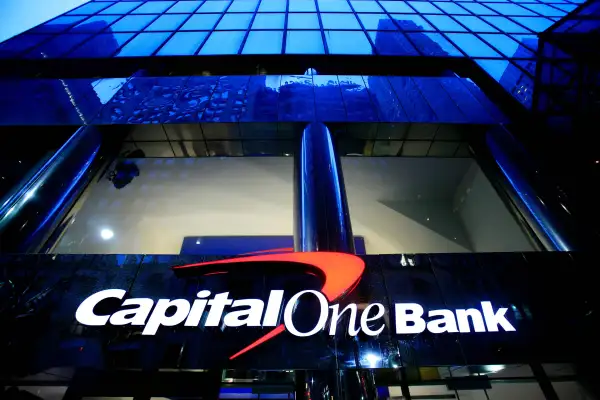Capital One Wipes Out Overdraft Fees, Plus How to Avoid Them at Your Bank

Capital One, the sixth largest bank in the U.S. and Money's pick for the overall "Best National Bank" in 2021, announced this week it will eliminate overdraft fees in 2022.
This means that if a customer makes a purchase without enough money in the account to cover the expense, Capital One will allow the transaction to go through without charging an overdraft fee.
Also called non sufficient-fund fees, overdraft fees kick in when you make a withdrawal or debit card payment that goes over the available balance in your account. The bank then covers the expense as part of its overdraft protection program, and it generally charges you a fee in the process for what amounts to a short-lived loan.
The average overdraft fee often rings in at about $35. So, say you’re covered by overdraft protection and you unwittingly pay for a $5 coffee with a $0 balance. You’ll get your coffee — and it'll wind up costing a real total of $40.
Overdraft fees bring in big bucks for banks. According to the Consumer Financial Protection Bureau (CFPB), the banking industry reeled in $15.5 billion in overdraft fees in 2019 — with JPMorgan Chase, Wells Fargo and Bank of America accounting for 44% of that revenue.
Before Capital One's change of policy, the bank would charge a $35 overdraft fee to its 360 Checking account customers who made a purchase without a balance large enough to cover it. Now that Capital One overdraft fees are gone, does it mean the bank will cover your overdrawn purchases indefinitely, with no limits? No. In an email to Money, Capital One said overdraft limits will depend on the customer's deposit history and risk profile.
The McLean, Virginia-based bank said customers who currently have overdraft protection will be automatically enrolled in the new no-fee overdraft program when it launches in the first half of 2022. All Capital One customers who don't have overdraft protection now can enroll in no-fee overdraft protection when it kicks off, via Capital One's mobile banking app or its online services.
With the announcement, Capital One joins a growing list of banks — many of them online institutions, like Ally — that are making overdraft fees a thing of the past.
Checking accounts with no overdraft fees
Capital One says it is "the only top-10 retail bank" to eliminate overdraft fees. But it is hardly the only financial institution that has ditched (or never charged) fees for overdrafts.
Here are some of the other banks whose checking accounts don't charge overdraft fees:
- Ally Bank Interest Checking Account
- Axos Essential Checking
- KeyBank Hassle-Free Account
- Discover Cash Back Checking Account
- Betterment Checking Account
- Wealthfront Checking Account
What banks charge overdraft fees?
Many of the largest banks in the U.S. still have accounts that can charge overdraft fees. Various accounts for banks like Chase, Wells Fargo, Citibank, U.S. Bank, PNC Bank, TD Bank, Fifth Third Bank and HSBC will assess overdraft fees of around $35 under certain circumstances.
The rules for when an overdraft fee kicks in can vary quite a bit between banks, and even sometimes among different kinds of accounts within the same bank. So it's very important to understand what kind of account you have and when an overdraft fee will be charged. There are also some easy strategies to help you avoid getting hit with an overdraft fee.
How to avoid overdraft fees
You can avoid overdraft fees entirely simply by opting out of overdraft protection. Generally speaking, you can opt out of overdraft protection via your mobile banking app, through your online account or by calling customer service.
Roughly a decade ago, the Federal Reserve enacted laws prohibiting banks from charging overdraft or non-sufficient fund fees unless the customer had specifically opted in to overdraft protection. (It's very possible that many bank customers have no idea whether or not they've opted in to such coverage, so it's worth checking with your bank to see your status.)
What happens if you opt out of overdraft protection? In most cases, a transaction that your balance can’t cover would be declined. That may be annoying. But it's probably better than letting the bank front the bill and then seeing a hefty overdraft fee charged to your account, especially with smaller purchases. Why pay $35 extra for a cup of coffee?
If your bank charges overdraft fees and you want to keep overdraft protection anyway, there are tactics to help you avoid surprise charges.
Some banks let you set up alerts on your mobile app, which notify you when your balance dips below a certain point. Several banks also let you link a savings account or credit card to your checking account. That way, when there isn't enough money in your checking account to cover a transaction, funds are automatically pulled from a linked account to cover it. (The bank may charge a fee for this service too, but it can be lower than the overdraft fee.)
Even after you get hit with an overdraft charge, you can contact the bank and ask for the fee to be waived. By calling your financial institution or visiting a branch, you can talk to a representative or manager — who often has the power to reverse the overdraft fee. But don't take advantage. Banks that waive overdraft fees do so at their own discretion, and they probably aren't going to help out if overdrawing your account becomes a habit.
More from Money
5 Best National Banks of 2021-2022
